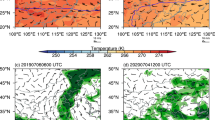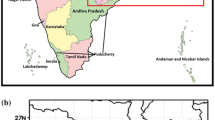Abstract
The relationship between the radar reflectivity factor (Z) and the rainfall rate (R) is recalculated based on radar observations from 10 Doppler radars and hourly rainfall measurements at 6529 automatic weather stations over the Yangtze–Huaihe River basin. The data were collected by the National 973 Project from June to July 2013 for severe convective weather events. The Z–R relationship is combined with an empirical qr–R relationship to obtain a new Z–qr relationship, which is then used to correct the observational operator for radar reflectivity in the three-dimensional variational (3DVar) data assimilation system of the Weather Research and Forecasting (WRF) model to improve the analysis and prediction of severe convective weather over the Yangtze–Huaihe River basin. The performance of the corrected reflectivity operator used in the WRF 3DVar data assimilation system is tested with a heavy rain event that occurred over Jiangsu and Anhui provinces and the surrounding regions on 23 June 2013. It is noted that the observations for this event are not included in the calculation of the Z–R relationship. Three experiments are conducted with the WRF model and its 3DVar system, including a control run without the assimilation of reflectivity data and two assimilation experiments with the original and corrected reflectivity operators. The experimental results show that the assimilation of radar reflectivity data has a positive impact on the rainfall forecast within a few hours with either the original or corrected reflectivity operators, but the corrected reflectivity operator achieves a better performance on the rainfall forecast than the original operator. The corrected reflectivity operator extends the effective time of radar data assimilation for the prediction of strong reflectivity. The physical variables analyzed with the corrected reflectivity operator present more reasonable mesoscale structures than those obtained with the original reflectivity operator. This suggests that the new statistical Z–R relationship is more suitable for predicting severe convective weather over the Yangtze–Huaihe River basin than the Z–R relationships currently in use.
Similar content being viewed by others
References
Bamba, B., A. D. Ochou, E. P. Zahiri, et al., 2014: Consistency in Z–R relationship variability regardless precipitating systems, climatic zones observed from two types of disdrometer. Atmos. Climate Sci., 4, 52479, doi: 10.4236/acs.2014.45083.
Battan, L. J., 1973: Radar Observation of the Atmosphere. University of Chicago Press, Chicago, 324 pp.
Bent, A. E., 1943: Radar Echoes from Atmospheric Phenomena. Massachusetts Institute of Technology, Radiation Laboratory, Cambridge, 173 pp.
Caracciolo, C., F. Porcù, and F. Prodi, 2008: Precipitation classification at mid-latitudes in terms of drop size distribution parameters. Adv. Geosci., 16, 11–17, doi: 10.5194/adgeo-16-11-2008.
Chen, F., and J. Dudhia, 2001: Coupling an advanced land surfacehydrology model with the Penn State-NCAR MM5 modeling system. Part I: Model implementation and sensitivity. Mon. Wea. Rev., 129, 569–585, doi: 10.1175/1520-0493(2001)129 <0569:CAALSH>2.0.CO;2.
Chen, Q. P., J. H. Yu, L. Z. Yang, et al., 2006: Analysis of quantitative precipitation estimation based on doppler radar data in pre-rainy season in northern and central Fujian. Meteor. Mon., 32, 56–61, doi: 10.3969/j.issn.1000-0526.2006.04.010. (in Chinese)
Chi, Z. P., X. Liu, and J. M. Chen, 2000: Calculation and analysis of Z–I relation among precipitation processes caused by sheet cloud in spring and autumn. Meteor. Mon., 26, 35–37, doi: 10.3969/j.issn.1000-0526.2000.01.007. (in Chinese)
Chumchean, S., 2004: Improved estimation of radar rainfall for use in hydrological modelling. Ph. D. dissertation, University of New South Wales, Sydney, Australia, 179 pp.
Dudhia, J., 1989: Numerical study of convection observed during the winter monsoon experiment using a mesoscale two-dimensional model. J. Atmos. Sci., 46, 3077–3107, doi: 10.1175/1520-0469(1989)046<3077:NSOCOD>2.0.CO;2.
Fujiwara, M., 1965: Raindrop-size distribution from individual storms. J. Atmos. Sci., 22, 585–591, doi: 10.1175/1520-0469(1965)022<0585:RSDFIS>2.0.CO;2.
Fulton, R. A., J. P. Breidenbach, D. J. Seo, et al., 1998: The WSR-88D rainfall algorithm. Wea. Forecasting, 13, 377–395, doi: 10.1175/1520-0434(1998)013<0377:TWRA>2.0.CO;2.
Grell, G. A., and D. Dévényi, 2002: A generalized approach to parameterizing convection combining ensemble and data assimilation techniques. Geophys. Res. Lett., 29, 38–1, doi: 10.1029/2002GL015311.
Hong, S. Y., J. Dudhia, and S. H. Chen, 2004: A revised approach to ice microphysical processes for the bulk parameterization of clouds and precipitation. Mon. Wea. Rev., 132, 103–120, doi: 10.1175/1520-0493(2004)132<0103:ARATIM>2.0.CO;2.
Huggel, A., W. Schmid, and A. Waldvogel, 1996: Raindrop size distributions and the radar bright band. J. Appl. Meteor., 35, 1688–1701, doi: 10.1175/1520-0450(1996)035<1688:RSDA TR>2.0.CO;2.
Imai, J., 1960: Raindrop-size distribution and Z–R relationships. Proceedings of the 8th Weather Radar Conference. San Francisco, CA, 11–14 April, Amer. Meteor. Soc., 211–218.
Janjić, Z. I., 1994: The step-mountain eta coordinate model: Further developments of the convection, viscous sublayer, and turbulence closure schemes. Mon. Wea. Rev., 122, 927–945, doi:1 0.1175/1520-0493(1994)122<0927:TSMECM>2.0.CO;2.
Jatila, E., and T. Puhakka, 1972: Experiments on the measurement of areal rainfall by radar. Geophysica, 12, 103–125.
Jones, D. M. A., 1956: Rainfall Drop Size-Distributions and Radar Reflectivity. Meteorologic Laboratory, Urbana, Illinois, 20 pp.
Joss, J., and E. G. Gori, 1978: Shapes of raindrop size distributions. J. Appl. Meteor., 17, 1054–1061, doi: 10.1175/1520-0450(1978)017<1054:SORSD>2.0.CO;2.
Lee, D. I., M. Jang, C. H. You, et al., 2002: Kuduck Dwsr-88c radar rainfall estimation and Z–R relationship by poss during 2001 in Korea. EGS XXVII General Assembly, Nice, 21–26 April, EGU, 2242.
Li, J. T., L. Guo, and H. P. Yang, 2005: A study of the formation of initial radar field in estimating areal rainfall using radar and rain-gauge. Chinese J. Atmos. Sci., 29, 1010–1020, doi: 10.3878/j.issn.1006-9895.2005.06.16. (in Chinese)
List, R., 1988: A linear radar reflectivity-rainrate relationship for steady tropical rain. J. Atmos. Sci., 45, 3564–3572, doi: 10.1175/1520-0469(1988)045<3564:ALRRRF>2.0.CO;2.
Liu, H. Y., H. M. Xu, Z. J. Hu, et al., 2007: Application of radar reflectivity to initialization of cloud resolving mesoscale model. Part I: Retrieval of microphysical parameters and vertical velocity. Acta Meteor. Sinica, 65, 896–905, doi: 10.11676/qxxb2007.084. (in Chinese)
Liu, J., Z. Z. Song, D. F. Liu, et al., 1999: Classified Z–I relationship and its application to the measurement of rainfall by weather radar over the Huaihe River basin. Scientia Meteor. Sinica, 19, 213–220. (in Chinese)
Liu, X. Y., H. P. Yang, J. T. Li, et al., 2010: CINRAD radar quantitative precipitation estimation group system. Meteor. Mon., 36, 90–95, doi: 10.7519/j.issn.1000-0526.2010.04.016. (in Chinese)
Lopez, P., and P. Bauer, 2007: “1D + 4DVAR” assimilation of NCEP stage-IV radar and gauge hourly precipitation data at ECMWF. Mon. Wea. Rev., 135, 2506–2524, doi: 10.1175/mwr3409.1.
Marshall, J. S., and W. M. K. Palmer, 1948: The distribution of raindrops with size. J. Meteor., 5, 165–166, doi: 10.1175/1520-0469(1948)005<0165:TDORWS>2.0.CO;2.
Marshall, J. S., W. Hitschfeld, and K. L. S. Gunn, 1955: Advances in radar weather. Adv. Geophys., 2, 1–56, doi: 10.1016/s0065-2687(08)60310-6.
Mlawer, E. J., S. J. Taubman, P. D. Brown, et al., 1997: Radiative transfer for inhomogeneous atmospheres: TMRR, a validated correlated-k model for the longwave. J. Geophys. Res., 102, 16663–16682, doi: 10.1029/97jd00237.
Moumouni, S., M. Gosset, and E. Houngninou, 2008: Main features of rain drop size distributions observed in Benin, West Africa, with optical disdrometers. Geophys. Res. Lett., 35, L23807, doi: 10.1029/2008GL035755.
Parrish, D. F., and J. C. Derber, 1992: The National Meteorological Center’s spectral statistical-interpolation analysis system. Mon. Wea. Rev., 120, 1747–1763, doi: 10.1175/1520-0493(1992)120<1747:TNMCSS>2.0.CO;2.
Rao, T. N., D. N. Rao, K. Mohan, et al., 2001: Classification of tropical precipitating systems and associated Z–R relationships. J. Geophys. Res., 106, 17699–17711, doi: 10.1029/2000jd900836.
Ren, Z. H., P. Zhao, Q. Zhang, et al., 2010: Quality control procedures for hourly precipitation data from automatic weather stations in China. Meteor. Mon., 36, 123–132, doi: 10.7519/j.issn.1000-0526.2010.07.019. (in Chinese)
Rogers, E., T. L. Black, D. G. Deaven, et al., 1996: Changes to the operational “early” Eta analysis/forecast system at the National Centers for Environmental Prediction. Wea. Forecasting, 11, 391–413, doi: 10.1175/1520-0434(1996)011<0391:CTTOEA> 2.0.CO;2.
Steiner, M., and R. A. Houze Jr., 1997: Sensitivity of the estimated monthly convective rain fraction to the choice of Z–R relation. J. Appl. Meteor., 36, 452–462, doi: 10.1175/1520-0450(1997)036<0452:SOTEMC>2.0.CO;2.
Stout, G. E., and E. A. Mueller, 1968: Survey of relationships between rainfall rate and radar reflectivity in the measurement of precipitation. J. Appl. Meteor., 7, 465–474, doi: 10.1175/1520-0450(1968)007<0465:SORBRR>2.0.CO;2.
Sun, J. Z., and N. A. Crook, 1997: Dynamical and microphysical retrieval from Doppler radar observations using a cloud model and its adjoint. Part I: Model development and simulated data experiments. J. Atmos. Sci., 54, 1642–1661, doi: 10.1175/1520-0469(1997)054<1642:DAMRFD>2.0.CO;2.
Tapiador, F. J., R. Checa, and M. de Castro, 2010: An experiment to measure the spatial variability of rain drop size distribution using sixteen laser disdrometers. Geophys. Res. Lett., 37, L16803, doi: 10.1029/2010GL044120.
Wang, S. X., Z. H. Bo, J. F. Zhang, et al., 2013: Localization of Z–I relation and RPG precipitation product improvement for weather radar. Meteor. Sci. Technol., 41, 430–435, doi: 10.3969/j.issn.1671-6345.2013.03.002. (in Chinese)
Wong, M. C., W. K. Wong, and E. S. T. Lai, 2006: From SWIRLS to RAPIDS: Nowcast Applications Development in Hong Kong. Proceedings of PWS Workshop on Warnings of Real-Time Hazards by Using Nowcasting Technology. Sydney, Australia, 9–13 October, WMO, 1–20.
Xiao, Q. N., Y. H. Kuo, J. Z. Sun, et al., 2007: An approach of radar reflectivity data assimilation and its assessment with the inland QPF of Typhoon Rusa (2002) at landfall. J. Appl. Meteor. Climatol., 46, 14–22, doi: 10.1175/JAM2439.1.
Xu, F., X. Y. Mu, W. F. Wang, et al., 2013: The application and discussion of classified optimization method on estimating precipitation in the region around Yangtze River in Jiangsu Province. J. Meteor. Sci., 33, 51–58, doi: 10.3969/2012jms.0064. (in Chinese)
Xue, M., 2016: Preface to the special issue on the “Observation, Prediction and Analysis of severe Convection of China” (OPACC) National “973” Project. Adv. Atmos. Sci., 33, 1099–1101, doi: 10.1007/s00376-016-0002-3.
Xue, M., and W. J. Martin, 2006: A high-resolution modeling study of the 24 May 2002 dryline case during IHOP. Part I: Numerical simulation and general evolution of the dryline and convection. Mon. Wea. Rev., 134, 149–171, doi: 10.1175/MWR3071.1.
Xue, M., K. K. Droegemeier, V. Wong, et al., 1995: The Advanced Regional Prediction System (ARPS) User’s Guide. Center for Analysis and Prediction of Storms, University of Oklahoma, Norman, 380 pp.
Yao, Y. F., M. H. Cheng, H. P. Yang, et al., 2007: Optimized Z-I relationship and its application to the measurement of rainfall in Huaihe basion. Meteor. Mon., 33, 37–43, doi: 10.3969/j.issn.1000-0526.2007.06.006. (in Chinese)
Zhang, C. Z., J. S. Xue, L. Zhang, et al., 2012: Study of the “1D + 3D var” assimilation of the rain rate retrieved from radar reflectivity and its experiments. Acta Meteor. Sinica, 70, 1128–1136, doi: 10.11676/qxxb2012.095. (in Chinese)
Acknowledgments
All the observational data used in this work were provided by the National (Key) Basic Research and Development (973) Program of China (2013CB430102). The NCEP-FNL datasets are available from https://doi.org/rda.ucar.edu/datasets/ds083.2/
Author information
Authors and Affiliations
Corresponding author
Additional information
Supported by the National (Key) Basic Research and Development (973) Program of China (2013CB430102) and National Natural Science Foundation of China (41275102 and 41330527).
Rights and permissions
About this article
Cite this article
Fang, X., Shao, A., Yue, X. et al. Statistics of the Z–R Relationship for Strong Convective Weather over the Yangtze–Huaihe River Basin and Its Application to Radar Reflectivity Data Assimilation for a Heavy Rain Event. J Meteorol Res 32, 598–611 (2018). https://doi.org/10.1007/s13351-018-7163-1
Received:
Accepted:
Published:
Issue Date:
DOI: https://doi.org/10.1007/s13351-018-7163-1




